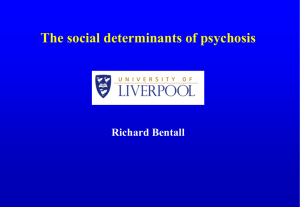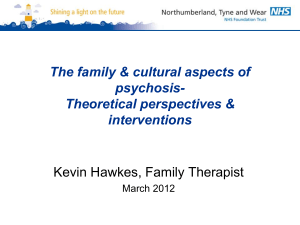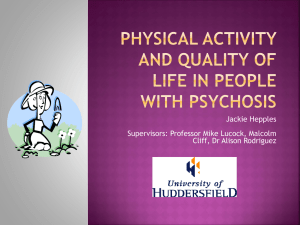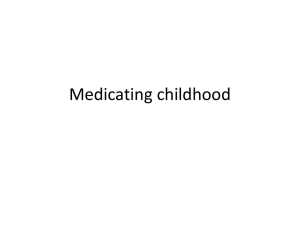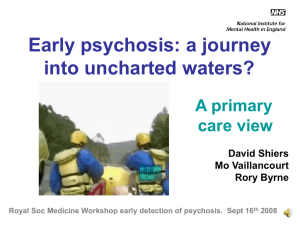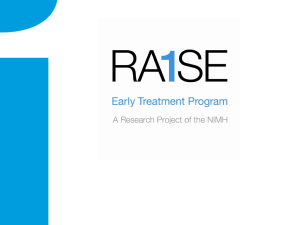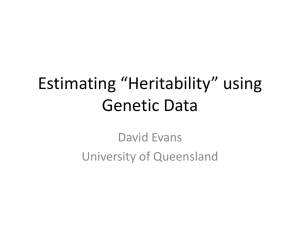Richard Bentall
advertisement
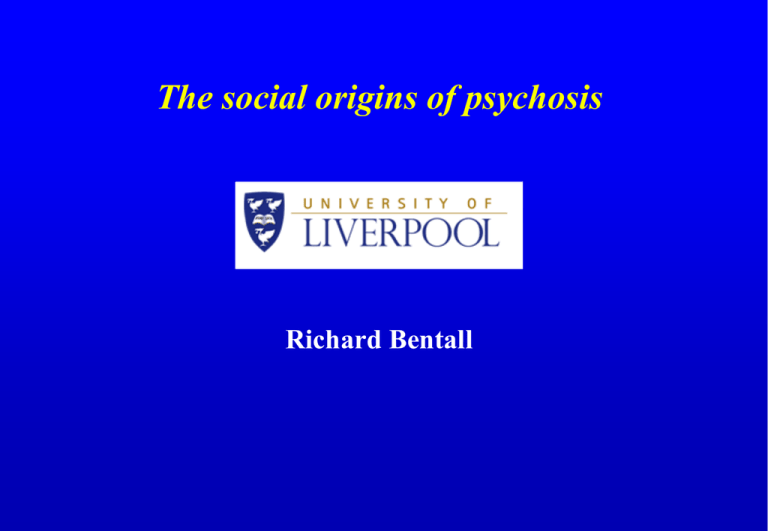
The social origins of psychosis Richard Bentall 1: Is schizophrenia a genetic disorder? Axiom or hypothesis? Throughout the history of psychiatry, the idea that schizophrenia and related conditions are genetic diseases has been treated as an axiom, rather than a hypothesis. For example, Rosenthal & Quinn (1977) investigated the Genain quadruplets apparently concordant for SZ. Given pseudonyms Nora, Ira, Myra and Hester. • Genain = dreadful gene! • Nora, Ira, Myra, Hester = NIMH! Axiom or hypothesis? Father often drank to excess, was described as unstable and paranoid. It seems likely that he sexually abused some of his daughters, as the investigators report that, “He chose Nora as his favourite, at times fondling her breasts and being intrusive when she was in the bathroom”. “Iris and Hester engaged in mutual masturbation and the parents, horrified, agreed with an attending physician to have both girls circumcised and their hands tied to their beds for thirty nights. Nora and Myra were not allowed to visit their sisters and ‘couldn’t understand the whole situation’. Three of the girls completed high school; Hester did not. Her parents kept her at home in her senior year and she cried a great deal.” 80% heritability? What does 80% heritable mean? • Heritability is often misunderstood to be a gene/environment causation ratio, because it is defined as the percentage of the variance in a trait that is attributable to genes (which looks like a G/E ratio) = variance with genes variance with genes + variance with environment • It is a statement about populations, not people. • An additive model is typically assumed: that high levels of heritability preclude environmental influences (i.e. variance due to genes + variance due to environment = 100% ) What does 80% heritable mean? • Heritability is often misunderstood to be a gene/environment causation ratio, because it is defined as the percentage of the variance in a trait that is attributable to genes (which looks like a G/E ratio) = variance with genes variance with genes + variance with environment If variance in the environment is low, heritability will always be high: If everyone smokes 20 cigarettes a day, the heritability of lung cancer will approach 100% (but the cause will still be smoking)! Turkheimer et al (2003), in a large twin study, found that 60% of variance in IQ in impoverished environment is attributable to shared environmental effects with close to zero genetic effects. The reverse was true in middle class families. What does 80% heritable mean? • Heritability is often misunderstood to be a gene/environment causation ratio, because it is defined as the percentage of the variance in a trait that is attributable to genes (which looks like a G/E ratio) = variance with genes variance with genes + variance with environment Heritability is inflated if genes cause exposure to particular environments: The heritability of lung cancer will be high if genes make us want to smoke, but if smoking causes the lung cancer. Dickins & Flynn (2001) – in an analysis of heritability of intelligence - have formally shown that high heritability estimates can mask strong environmental effects if there are GxE correlations, which seems likely in the case of psychosis. Many genes with very small effects? International Schizophrenia Consortium (2009) Relaxed statistical rules to identify genes with very modest associations with schizophrenia (more than 1000, usually associated with an increased risk of < .02%). Created sum scores for polygenic association: • Accounted for about 30% of the variance in liability to schizophrenia • Accounted for a similar liability to bipolar disorder 2: Environmental factorsCitys and social disadvantage and migration Psychosis and the city Faris and Dunham’s famous (1939) famous study of Chicago appeared to show that inner city environments are associated with a high risk of psychosis. • Often attributed to ‘downwards social drift’ Psychosis and the city: Recent studies • Pedersen & Mortensen (2001), in a survey of nearly 2 million Danish adults, found a dose-response relationship between exposure to an inner city environment < 15 years and risk of psychosis. • Weiser et al. (2007), looked at cognitive functioning and place of birth as predictors of psychosis in Israeli draftees (N = 371603). Increase in risk due to urbanicity was 9 x greater in those with low cognitive function. Psychosis and social disadvantage Wicks et al (2010) : social risk or genetic liability for psychosis? • 13, 163 children born between 1955 and 1984 and reared in Swedish adoptive families were linked to the National Patient Register for non-affective psychosis. • Socioeconomic position identified through national census data • Genetic liability identified through cross reference with inpatient care notes of mother. RESULTS: Social disadvantage increases risk for psychosis. Also an interaction: social disadvantage increases the risk more in children with genetic liability. Is it inequality that is most important? Wilkinson and Pickett (2008) have gathered together an impressive array of evidence showing that social inequality (not wealth) is related to almost all forms of negative outcomes including; • Crime • Low birth weight • Shorter height • Teenage pregnancies • Physical health • Mental health Why inequality? The strong effect for inequality points to the importance of social comparison and other psychological mechanisms. • Wilkinson & Pickett (2008) point to strong evidence that negative social comparison affects the HPA axis, but other mechanisms are also possible. • This effect has been reported for psychosis (Boydell et al. 2004; Burns & Esterhuizen, 2008; Kirkbride et al. 2013) Psychosis and migration Afro-Carribeans living in the UK have a high risk of paranoid and manic psychosis. Although this may partly be due to misdiagnosis and cultural insensitivity of white psychiatrists (Littlewood & Lipsedge, 1989): • It is found in community surveys (Harrison et al., 1988) • Rediagnosis by Afro-Carribean psychiatrists does not alter rates (Hicking et al. 1999) • Incidence rate is not abnormally high in the Carribean (Hickling, 1995; Bhugra et al. 1996) Psychosis and migration Recent studies have shown that: • Immigrants in other countries are affected - for example, Surinamese immigrants to Holland (Selten et al, 2000), Morocan immigrants to Holland (Velling et al. 2007) and East African immigrants to Sweden (Zolkowska et al, 2001). • In the UK, Afro-Caribbeans living in white neighbourhoods are especially vulnerable (Boydell et al, 2001). • Veling et al (2007) investigated perceived discrimination in Moroccan (high), Surinames (medium), Turkish (low) and European (very low) immigrants living in the Hague. Rates of psychosis varied accordingly. 4: Environmental factorsChildhood trauma Meta-analysis Initial database search found 27,572 hits- 763 remaining papers were examined for inclusion. The analysis refers to studies focusing on EARLY adversity (exposure to trauma, bullying, parental death etc before the age of 18) and psychosis (both diagnostic and dimensional outcomes) with the following designs: • epidemiological cross-sectional studies (8) • prospective studies (and quasi prospective studies) (10) • patient control studies (18) Meta-analysis Meta-analysis We found a significant association between trauma and psychosis across all different research designs: • patient-control studies: OR = 2.72 • epidemiological cross-sectional: OR = 2.99 • prospective: OR = 2.75 9/10 of the datasets investigated for dose-response relationships found them. In the case of cumulative trauma, odds ratios increased dramatically (e.g., in the National Comorbidity Survey, from 2.53 for 1 type of trauma to 53.26 for 5 types of trauma; Shevlin et al. 2007). How big is the effect? Khuder (2001) meta-analysed evidence on the relationship between smoking and specific kinds of lung cancer: • For squamous cell carcinoma (highest risk) the ORs varied from 3.38 to 33.60 according to duration of smoking (1 – 40+ years). The odds ratios observed in our meta-analysis are in the same general range! How big is the effect? Averaged across the studies, the population attributable risk (proportion of people who would not have become psychotic, had the risk factor not been present) was 33% (range 15% - 48%). In the UK, this is about 160,000 people who either have been or will be diagnosed as suffering from schizophrenia or a related condition during their lifetime. Or slightly more than the population of Huddersfield *. * A small city in the North of England. Specificity of adversities for symptoms Specific associations between specific kinds of adversity and specific kinds of symptoms have recently been explored in the 2007 Adult Psychiatric Morbidity survey (Bentall et al., 2012): CSA-> hallucinations; disrupted attachment relationships -> paranoia. Specificity of adversities for symptoms We have replicated these associations in an analysis of data from the US National Comorbidity Study, N = 5877 from the 48 coterminus states of the USA (Sitko, Sellwood & Bentall, in subm): Reactions Susser and Widom (2012): Argue that the evidence is too consistent, and that this is likely to be because of reporting bias. BUT Fisher et al. (2011) found that patients reports of childhood experience did not change when their symptoms remitted, and were concordant with reports by other sources (sibs). Reactions Sideli et al. (2012): “specificity of childhood abuse in psychotic disorders and, particularly, in schizophrenia has not been demonstrated….” “.the case cannot be regarded as proven. So far none of the studies reported indicate that childhood abuse is either sufficient or necessary to develop a psychotic disorder….” “the possibility cannot be ruled out that a child destined to develop schizophrenia may show characteristics in childhood that increase the risk of abuse” 5: Plausible mechanisms? But is social adversity causal? Austin Bradford Hill (1897-1991) proposed a series of criteria for inferring causality from epidemiological data (1965): 1. 2. 3. 4. 5. 6. 7. 8. 9. Strength of association Consistency Specificity Temporal relationship Biological gradient/dose-response Plausibility in terms of mechanisms Coherence Reversibility Consideration of alternative explanations. But is social adversity causal? Austin Bradford Hill (1897-1991) proposed a series of criteria for inferring causality from epidemiological data (1965): 1. 2. 3. 4. 5. 6. 7. 8. 9. Strength of association Consistency Specificity Temporal relationship Biological gradient/dose-response Plausibility in terms of mechanisms Coherence Reversibility Consideration of alternative explanations. Social defeat? Selten & Cantor-Graee (2005) argue that environmental risk-factors that are linked to psychosis can all be encompassed under the concept of social defeat. They point to animal studies of social defeat that show social defeat (or at least, chronic victimization) affects sensitivity of the dopamine system. Paranoia as the end point of a developmental pathway Psychological description: Insecure attachment Victimisation/ powerlessness Abnormal cognitive style Threat anticipation Paranoia Paranoia as the end point of a developmental pathway Physiological description: Insecure attachment Victimisation/ powerlessness Abnormal cognitive style Abnormal striatal dopamine Paranoia Hallucinations as an end point of a developmental pathway Impaired communication between frontal and temporal brain regions Impaired source monitoring Hallucinations Trauma Dissociation 6: Conclusions and implications For patients and families • ‘Mental health literacy’ campaigns typically emphasize the idea that ‘schizophrenia’ is an illness like any other illness – a genetically determined brain disease. • In fact, both observational and experimental research shows that biogenic beliefs about mental illness are associated with negative, more stigmatizing attitudes towards the mentally ill. For patients and families • Patients often complain that the role of the experience in their difficulties is routinely ignored by psychiatric services. • Slater (2004) informally replicated Rosenhan’s (1970) famous ‘being sane in insane places’ experiment. “I was mislabelled but not locked up. Here’s another thing that’s different: every single medical professional was nice to me. Rosenhan and his confederates felt diminished by their diagnoses. I, for whatever reason, was treated with palpable kindness. One psychiatrist touched my arm. One psychiatrist said, “Look, I know it’s scary for you, hearing a voice like that, but I really have a feeling that the Risperdal will take care of this.” But she was only once asked a personal question (what was her religion?)! For patients and families • Patients often complain that the role of the experience in their difficulties is routinely ignored by psychiatric services. • McCabe and Priebe (2004) filmed NHS psychiatrists at work in their outpatient clinics. When patients asked about the meaning of their symptoms, the psychiatrists: “Hesitated, responded with a question rather than with an answer, and smiled or laughed (when informal carers were present), indicating that they were reluctant to engage with patients' concerns about their psychotic symptoms”. For therapy Is it possible that trauma-focused treatments will be effective in the treatment of patients with psychosis? • Mueser et a. (2008) have reported promising although modest effects of CBT trauma-based interventions for patients with comorbid psychosis and PTSD but many patients with a trauma history do not meet the criteria for PTSD. For public mental health The prevalence of both common and severe psychiatric disorders has been increasing in the developed world (Whitaker, 2005). Maybe that’s not surprising given the socioeconomic drivers of mental ill health: •Social inequality •Job insecurity and unemployment, fuelled by austerity measures •Isolation (low social capital) •Migration •Exposure to urban environments All these drivers are going in the wrong direction! And they are not going to fixed by mass psychopharmacology or psychotherapy!
